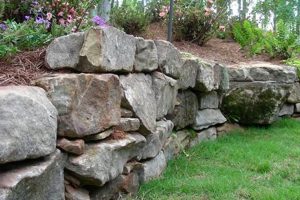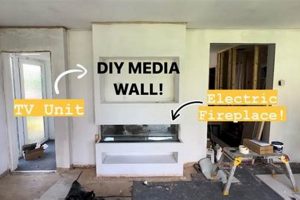A decorative wall treatment constructed from individual wooden strips, often arranged in parallel or grid-like patterns, has gained considerable traction in interior design. These structures serve as both aesthetic features and, in some instances, provide acoustic dampening or visual screening capabilities. The construction process typically involves securing the wooden elements to a backing surface, such as drywall or plywood, using adhesive, fasteners, or a combination thereof.
The appeal of this design element lies in its adaptability and the capacity to introduce texture and visual interest to a space. Historically, wood paneling has been utilized in architecture for centuries, evolving from functional insulation to sophisticated decorative applications. Contemporary interpretations emphasize minimalist design, sustainability, and the ability to customize the appearance based on individual preferences. This form of wall decor can improve acoustics, add warmth, and create a focal point within a room.
The subsequent sections will explore various design considerations, material selections, installation techniques, and maintenance strategies relevant to creating this customized wall feature, providing readers with the necessary information to successfully implement such a project.
Essential Considerations for Wood Slat Wall Construction
The following points outline critical aspects to consider before and during the creation of a wooden slat feature wall, ensuring a structurally sound and aesthetically pleasing result.
Tip 1: Material Selection: Opt for wood species appropriate for the intended environment. Consider moisture resistance for bathrooms or kitchens. Hardwoods offer durability, while softwoods provide cost-effectiveness, though potentially at the expense of longevity. Evaluate wood grain and color consistency across all slats prior to installation.
Tip 2: Accurate Measurements: Meticulous measurement of the wall is paramount. Account for any irregularities in the wall surface and ensure precise slat spacing to maintain visual symmetry and prevent compounding errors across the wall’s width or height.
Tip 3: Substrate Preparation: Prepare the wall surface by ensuring it is clean, level, and structurally sound. Repair any damage prior to installation. A solid, even substrate is essential for secure slat attachment and prevents warping or unevenness over time.
Tip 4: Secure Attachment Methods: Select appropriate fasteners or adhesives based on the wall material and the weight of the wood slats. Screws provide a mechanical bond, while construction adhesive offers a surface bond. Using both can enhance the wall’s structural integrity. Verify that fasteners penetrate sufficiently into the wall studs, if applicable.
Tip 5: Consistent Spacing: Employ spacers during installation to guarantee uniform gaps between slats. This ensures a professional finish and maintains visual balance. Laser levels or chalk lines can assist in maintaining horizontal and vertical alignment throughout the installation process.
Tip 6: Finishing and Sealing: Apply a protective finish or sealant to the wood to enhance its durability and resistance to moisture, UV light, and general wear and tear. Select a product appropriate for the wood species and the intended aesthetic. Consider pre-finishing the slats prior to installation for optimal coverage and efficiency.
Tip 7: Acclimation Period: Allow the wood slats to acclimate to the room’s environment for several days prior to installation. This minimizes warping or shrinkage after installation, caused by changes in temperature or humidity. Store the slats flat in the intended room to ensure proper acclimation.
Adhering to these recommendations will enhance the structural integrity, visual appeal, and longevity of the wood slat wall, creating a refined interior feature.
The following sections provide detailed information regarding best practices for specific applications and design considerations.
1. Wood Species
The selection of wood species is a foundational decision in the creation of a wooden slat feature wall. The chosen material influences not only the aesthetic characteristics but also the structural integrity, longevity, and overall cost of the finished installation.
- Hardwood vs. Softwood Characteristics
Hardwoods, derived from deciduous trees, typically offer greater density and resistance to wear. Examples include oak, maple, and walnut. These are suitable for high-traffic areas or installations requiring increased durability. Softwoods, originating from coniferous trees such as pine, cedar, and fir, are generally more cost-effective and easier to work with, but exhibit lower resistance to dents and scratches. They may be appropriate for decorative applications in low-impact zones.
- Aesthetic Considerations
Different wood species exhibit distinct grain patterns, colors, and textures. The selection must align with the intended design aesthetic. For example, walnut provides a rich, dark tone suitable for sophisticated interiors, while maple offers a lighter, more neutral palette adaptable to various styles. The grain pattern, whether straight, swirling, or figured, contributes significantly to the wall’s visual character.
- Moisture Resistance and Environmental Factors
Wood species vary in their ability to withstand moisture. In areas with high humidity or potential water exposure, such as bathrooms or kitchens, moisture-resistant woods like cedar or redwood are preferable to prevent warping, rot, or mold growth. Consider also the effects of UV light on different wood types, as some may fade or discolor more rapidly than others.
- Cost and Availability
The cost of different wood species can vary significantly depending on rarity, processing requirements, and geographic availability. Exotic hardwoods are generally more expensive than commonly available softwoods. Sourcing sustainable and locally harvested wood contributes to environmental responsibility and may influence overall project costs.
The thoughtful selection of wood species is therefore paramount in crafting a visually appealing, structurally sound, and long-lasting wooden slat wall. Balancing aesthetic preferences with performance requirements and budgetary constraints is essential for a successful installation that enhances the intended interior space.
2. Slat Spacing
Slat spacing, the distance between individual wooden strips in a slat wall construction, is a critical determinant of the final aesthetic, acoustic properties, and material efficiency. Precise control over this variable is paramount for a successful installation.
- Aesthetic Impact and Visual Perception
Slat spacing directly influences the overall visual density and perceived texture of the finished wall. Narrow spacing creates a more solid, uniform appearance, potentially emphasizing the material’s color and grain. Wider spacing introduces greater visual contrast and reveals more of the substrate behind the slats, altering the wall’s perceived depth and dimension. For instance, a minimalist design might utilize wider spacing to create a lighter, more airy feel, while a more traditional design could employ narrower spacing for a richer, more substantial look. Deviations from consistent spacing can disrupt the intended visual harmony.
- Acoustic Performance and Sound Absorption
The spacing between slats affects the wall’s ability to absorb sound. Narrower gaps tend to reflect sound waves, while wider gaps can allow sound to penetrate and be absorbed by the substrate or any acoustic backing material installed behind the slats. The strategic selection of slat spacing can therefore contribute to improved room acoustics, reducing reverberation and echo. In spaces requiring enhanced sound control, such as home theaters or music rooms, closer slat spacing combined with appropriate sound-absorbing materials is often preferred.
- Material Efficiency and Cost Optimization
Slat spacing dictates the amount of wood required for the project. Wider spacing reduces the total linear footage of wood needed, lowering material costs. However, this must be balanced against the desired aesthetic and performance characteristics. The optimal spacing represents a compromise between material economy and the intended visual and acoustic effect. Proper planning and calculation of slat spacing can significantly minimize material waste and overall project expenses.
- Structural Considerations and Support
While primarily aesthetic, slat spacing can indirectly impact the structural integrity of the overall wall system. Extremely wide spacing may require additional support or reinforcement of the backing substrate to prevent sagging or instability, particularly if heavier wood species are used. Consideration should be given to the load-bearing capacity of the wall and the potential need for vertical supports or intermediate bracing, depending on the selected slat spacing and the overall dimensions of the installation.
In conclusion, slat spacing is not merely an arbitrary decision but a deliberate design choice that profoundly impacts the visual, acoustic, and economic aspects of a slat feature wall. Careful consideration of these factors is crucial to achieving the desired outcome and creating a cohesive and functional interior space. The specific application and desired performance criteria should guide the selection of appropriate slat spacing to maximize the effectiveness of this design element.
3. Attachment Method
The selection of an appropriate attachment method is paramount to the structural integrity and longevity of any wooden slat feature wall. The attachment method directly dictates the stability of the slat arrangement and its resistance to environmental factors such as humidity and temperature fluctuations. Improper attachment can lead to slat detachment, warping, or even complete structural failure of the wall. For example, employing insufficient adhesive on a wall subjected to high humidity can result in adhesive bond failure and subsequent slat separation. Consequently, the choice of attachment method should be based on substrate material, slat weight, and environmental conditions.
Several common attachment methods exist, each with specific advantages and disadvantages. Mechanical fastening, such as screws or nails, provides a robust connection, especially when anchored into wall studs. However, this method necessitates precise alignment and risks splitting the wood slats if not pre-drilled. Adhesive bonding offers a cleaner, fastener-free aesthetic but relies heavily on surface preparation and the selection of a compatible adhesive. Hybrid methods, combining mechanical fasteners and adhesive, can provide a balanced approach, maximizing strength while minimizing visible fasteners. In instances where access to wall studs is limited or the substrate is unsuitable for mechanical fastening, construction-grade adhesive combined with temporary bracing during the curing process can achieve a secure bond. Furthermore, the direction of slat installation, whether horizontal or vertical, can also impact the selection of fastener length and placement.
In summary, the attachment method represents a critical engineering aspect of the wooden slat wall construction. Its selection directly influences the wall’s durability, aesthetic appeal, and overall safety. Proper assessment of substrate material, slat properties, and environmental factors, followed by the implementation of an appropriate attachment strategy, is essential for creating a stable and visually appealing slat wall feature that withstands the test of time.
4. Wall Alignment
Wall alignment is a foundational prerequisite for a successful DIY wood slat wall installation. Deviations from true vertical or horizontal, whether in the original wall structure or in the application of the wood slats, propagate visual distortions and compromise the intended aesthetic. The effect of misalignment is cumulative; even small errors, if uncorrected, amplify across the expanse of the wall, leading to a finished product that appears unprofessional and undermines the overall design intent. For example, a wall with an imperceptible slope, if left unaddressed, will result in increasingly uneven slat spacing as the installation progresses upwards. This unevenness becomes progressively more noticeable, drawing unwanted attention and detracting from the intended design.
Precise alignment requires the use of leveling tools and careful measurement. Laser levels or spirit levels, in conjunction with straight edges and measuring tapes, are essential for establishing accurate reference lines. These reference lines guide the placement of the first slat and subsequent slats, ensuring consistent spacing and orientation. Furthermore, it may be necessary to shim or furr out sections of the wall to correct for underlying irregularities. This process involves adding thin strips of material behind the slats to bring them into plane with each other, compensating for variations in the wall surface. Without this preparatory work, the finished slat wall will mirror the imperfections of the original wall, resulting in an uneven and visually unappealing outcome. The use of plumb bobs can verify vertical alignment, particularly in older structures where walls may have settled or shifted over time.
Achieving accurate wall alignment during the installation of a DIY wood slat wall presents a significant challenge, particularly for novice constructors. Overcoming this hurdle necessitates meticulous planning, precise measurement, and the use of appropriate leveling tools. The effort invested in achieving true wall alignment yields a finished product that exhibits professional quality, enhances the aesthetic appeal of the space, and provides long-term visual satisfaction. The adherence to proper alignment principles ultimately determines the success of the entire project, influencing not only the visual outcome but also the perceived value and craftsmanship of the installation. Ignoring wall alignment is a critical oversight, with ramifications for the longevity and visual impact of the finished piece.
5. Surface Finish
Surface finish is a critical factor influencing the aesthetic appeal, durability, and longevity of a wooden slat feature wall. The choice of finish extends beyond mere visual preference, impacting the wood’s resistance to moisture, UV radiation, and physical wear. Selecting an appropriate surface finish constitutes a fundamental step in the construction and maintenance of a visually appealing and durable wooden slat wall.
- Protection Against Environmental Factors
A primary function of a surface finish is to protect the wood from environmental stressors. Moisture penetration can cause warping, swelling, and rot, particularly in humid environments. UV radiation can fade or discolor the wood over time. A protective coating, such as varnish or polyurethane, creates a barrier against these elements, extending the lifespan of the slat wall. For example, an exterior-grade sealant applied to a slat wall in a sun-exposed room will mitigate fading and prevent moisture damage, ensuring the wood maintains its intended color and structural integrity.
- Aesthetic Enhancement and Design Versatility
Surface finishes significantly alter the appearance of the wood. Clear finishes accentuate the natural grain and color, while stains allow for a customized aesthetic, enabling a range of hues from light to dark. Matte finishes offer a subtle, natural look, while gloss finishes provide a reflective sheen. The choice of finish dictates the overall style of the slat wall, influencing its compatibility with the surrounding interior design. For instance, a dark stain and matte finish may complement a rustic or industrial aesthetic, while a clear gloss finish enhances the natural beauty of lighter woods in a modern setting.
- Durability and Resistance to Wear
The surface finish impacts the wood’s resistance to scratches, dents, and stains. A durable finish, such as polyurethane or epoxy, creates a hard, protective layer that withstands daily wear and tear. This is particularly important in high-traffic areas where the slat wall is susceptible to accidental contact or abrasion. For instance, a slat wall in a hallway or entryway benefits from a robust finish that resists scuff marks and maintains its appearance over time. The application of multiple coats, combined with proper sanding between coats, enhances the finish’s durability.
- Ease of Maintenance and Cleaning
The selected surface finish affects the ease with which the slat wall can be cleaned and maintained. Smooth, non-porous finishes, such as varnish or lacquer, repel dirt and allow for easy wiping. Textured or matte finishes may require more diligent cleaning to remove dust and grime. The choice of finish should consider the level of maintenance required to keep the slat wall looking its best. For example, a satin finish in a kitchen may be preferable due to its ease of cleaning compared to a more porous, textured finish that could trap grease and food particles.
These facets demonstrate the interconnectedness of surface finish and the overall success of a DIY wood slat wall project. Selecting the correct finish involves careful consideration of aesthetic preferences, environmental factors, and maintenance requirements. A well-chosen and properly applied surface finish not only enhances the beauty of the wood but also protects it from damage, ensuring the long-term durability and visual appeal of the installation. The ultimate result is a striking and lasting architectural feature within the interior space.
6. Acoustic Properties
Acoustic properties represent a crucial, often underestimated, aspect of DIY wood slat wall design and implementation. The strategic arrangement and material selection of wooden slats can significantly alter the soundscape of a room, affecting reverberation time, sound clarity, and overall acoustic comfort.
- Sound Diffusion and Scattering
Slat walls, by virtue of their non-uniform surface, contribute to sound diffusion. Sound waves striking the slats are scattered in multiple directions, reducing focused reflections and diminishing the intensity of echoes. The effectiveness of sound diffusion depends on the slat width, spacing, and surface texture. For example, wider slats with irregular surfaces promote greater diffusion compared to narrow, smooth slats. This scattering effect can improve speech intelligibility and create a more balanced acoustic environment.
- Sound Absorption through Air Gaps
The air gaps between slats act as Helmholtz resonators, trapping sound waves within the cavities and dissipating energy through friction. The frequency at which this absorption occurs is determined by the size and depth of the air gaps. To enhance sound absorption, acoustically absorbent material, such as mineral wool or fiberglass insulation, can be placed behind the slats. This combination is particularly effective at absorbing mid-range frequencies, common in speech and music. In a home theater, incorporating such materials behind a wood slat wall can minimize unwanted reflections and improve sound clarity.
- Frequency-Dependent Absorption and Reflection
Different slat designs exhibit varying acoustic properties across the frequency spectrum. Narrow slats with minimal spacing tend to reflect higher frequencies, while wider slats with larger air gaps are more effective at absorbing lower frequencies. This frequency-dependent behavior can be exploited to tailor the acoustic response of a room. For instance, combining different slat widths and spacings can create a more balanced acoustic environment, addressing both high- and low-frequency reflections. Properly designed, a slat wall can mitigate flutter echoes and standing waves, improving the overall acoustic quality of the space.
- Material Resonance and Vibration Damping
The choice of wood species and its inherent resonance properties influences the acoustic performance of the slat wall. Denser woods, such as hardwoods, tend to reflect more sound, while softer woods exhibit greater damping characteristics. Furthermore, the manner in which the slats are attached to the wall affects their vibration behavior. Rigidly fixed slats transmit vibrations more readily, while decoupled or resiliently mounted slats dampen vibrations, reducing sound transmission. The careful selection of wood species and mounting techniques can minimize unwanted resonances and improve acoustic isolation.
By strategically manipulating these acoustic properties, DIY wood slat walls offer a versatile solution for enhancing the soundscape of interior spaces. The effective integration of sound diffusion, absorption, and vibration damping can transform a room from an acoustically challenging environment into one conducive to focused work, immersive entertainment, or relaxed conversation. The design choices of slat width, spacing, backing material, and wood species all collectively contribute to the final acoustic outcome, requiring careful consideration to achieve the desired acoustic goals.
Frequently Asked Questions
The following section addresses common inquiries regarding the design, construction, and maintenance of a customized wood slat wall, providing detailed and factual responses to ensure project success.
Question 1: What wood species are best suited for areas with high humidity?
Wood species exhibiting inherent moisture resistance are preferable for humid environments. Cedar, redwood, and teak possess natural oils that repel water, mitigating warping and rot. Proper sealing, regardless of species, is recommended to provide an additional barrier against moisture penetration.
Question 2: How does slat spacing impact acoustic performance?
Slat spacing influences sound absorption and diffusion. Narrower spacing reflects higher frequencies, while wider spacing allows lower frequencies to penetrate. Introducing acoustic backing material behind the slats enhances sound absorption across a broader frequency range.
Question 3: What attachment methods provide the most secure installation?
A combination of mechanical fasteners and adhesive bonding offers optimal security. Screws or nails anchored into wall studs provide structural support, while construction adhesive ensures surface adhesion. The specific selection depends on the substrate material and slat weight.
Question 4: How can wall alignment be ensured during installation?
Employing laser levels or spirit levels is essential for establishing accurate horizontal and vertical reference lines. Shimming or furring out sections of the wall may be necessary to compensate for underlying irregularities and achieve a planar surface.
Question 5: What type of surface finish is recommended for enhanced durability?
Durable finishes, such as polyurethane or epoxy, create a hard, protective layer resistant to scratches, dents, and stains. The number of applied coats, along with proper sanding between coats, contributes to the finish’s overall longevity.
Question 6: How should wood slats be acclimated prior to installation?
Allow the wood slats to acclimate to the room’s environment for several days before installation. Store the slats flat in the intended room to minimize warping or shrinkage due to changes in temperature and humidity.
In summary, careful consideration of wood species, slat spacing, attachment methods, wall alignment, surface finish, and acclimation procedures is critical for a successful outcome. Adherence to these guidelines will enhance the visual appeal, structural integrity, and long-term performance of the constructed feature.
The subsequent section offers practical advice on maintaining the aesthetic quality of the wood slat wall over time.
Conclusion
This exploration of the “diy wood slat wall” has underscored the multifaceted considerations inherent in its design and construction. From the selection of appropriate wood species and the precise calculation of slat spacing to the critical importance of secure attachment methods and accurate wall alignment, each element plays a vital role in the final outcome. The application of a durable surface finish and the management of acoustic properties further contribute to the longevity and functionality of the installation.
Successfully executing a wood slat wall project demands meticulous planning, technical proficiency, and a commitment to quality craftsmanship. By adhering to the principles outlined herein, individuals can create visually striking and acoustically enhanced interior spaces that reflect both personal style and a dedication to enduring design. Diligence and precision remain paramount in achieving a lasting and impactful architectural feature.







